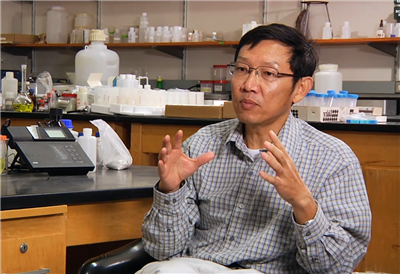
Credit: University of Wisconsin-Parkside
March 20, 2012
By Aaron R. Conklin
You could call it a case of environmental dominoes, a cause-and-effect cascade that slides down to affect the smallest organisms in potentially profound ways. It begins simply enough: Farmers may add common antibiotics like tetracycline to their livestock feed to help fend off diseases. Those antibiotics may excrete from the animals unmetabolized and enter soil or surface water after the famers apply animal manure as fertilizer. That’s where they may be having an effect on soil microbes.
While some researchers are focusing on quantifying antibiotics in water systems and others are searching for methods of removing them, Zhaohui “George” Li, professor and chair of the Geosciences Department at the University of Wisconsin-Parkside, is focusing his energies on what’s going on with those soil microbes in the presence of adsorbed antibiotics on clay minerals surfaces or in the interlayers. Using funds provided by the UW’s Water Resources Institute, he’s been able to characterize the ways in which antibiotics are absorbed into the two most common types of clay minerals in Wisconsin soil, where they begin to interact with—and possibly mutate—soil microbes.
“These minerals have large surface areas,” explained Li, who’s been working on this topic since 2008. “They could absorb a lot of things, including feedstock antibiotics.”
Similar to the ways a water softener functions to absorb/remove calcium and phosphorous from drinking water, certain clay minerals have a high capacity to absorb the ionic-charged antibiotic molecules on surface and in the interlayer.
The science of how it happens is determined by the type of clay mineral. Li likens smectite, the most common type of clay mineral in certain parts of Wisconsin, to a hardcover book with many pages. The antibiotics get onto the cover paper as well as into the inner pages, which can affect the germicidal effect of the antibiotics. Kaolinite, a clay mineral more commonly found in Southeastern US, is more like a book that has its pages glued shut, leaving only the surface area as a place for antibiotics to be absorbed and affect microbes.
Li’s current work is threefold: He’s trying to quantify how much antibiotic each type of clay can absorb, and identify under what conditions the amount absorbed might increase. (Hint: It’s likely linked to changes in pH.) If the pH levels do change, how does that affect the stability of adsorbed antibiotics? And finally, the biggest and most critical piece: When the antibiotics are absorbed into the surface of the clay, are they strong enough to continue attacking bacteria in soils?
If they are, it could have serious implications for infectious disease control. “If these antibiotics are functioning and reacting to microbes, maybe not quite to the degree where they can kill them, the microbes can begin developing resistance to antibiotics.”
New resistant bacteria strains could end up posing a threat not just to livestock, but to humans as well.
“If the antibiotics in fact are no longer active, that’s not a bad situation,” noted Li. “The clay minerals have strong adsorption for certain antibiotics, which will decrease the antibiotic concentration in the aqueous phase significantly. Our next thing is to think about how they can be degraded and removed through photoreactions once they’ve been intercalated into the interlayer of swelling clays.”
And that’s exactly where Li’s work will focus next—exploring whether it’s possible to accelerate the degradation by exposing the antibiotic-adsorbed clay minerals to ultraviolet rays. “There are still a lot of things that need to be studied,” said Li. “Now that we can detect these antibiotics in surface water and minerals, it becomes a question of gauging the extent of environmental pollution. This is an emerging issue.”



